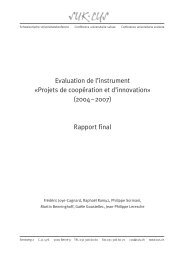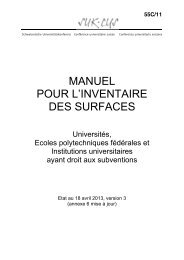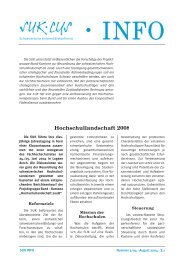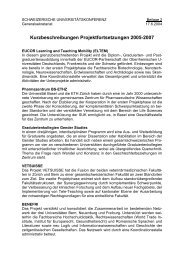Evaluation of the Swiss Virtual Campus - Schweizerische ...
Evaluation of the Swiss Virtual Campus - Schweizerische ...
Evaluation of the Swiss Virtual Campus - Schweizerische ...
Create successful ePaper yourself
Turn your PDF publications into a flip-book with our unique Google optimized e-Paper software.
SVC Final <strong>Evaluation</strong>. Background Report Lepori and Probst<br />
shows that <strong>the</strong>re is a certain risk that, after a certain time, projects do no longer respond to <strong>the</strong><br />
requirements <strong>of</strong> curricula or people.<br />
It is, however, possible, that over <strong>the</strong> whole number <strong>of</strong> projects <strong>the</strong>re is a higher share <strong>of</strong><br />
projects which do no longer exist or are not likely to continue existing for more than one or two<br />
years, because one could assume that those projects responding to <strong>the</strong> questionnaire are those<br />
that are more active, while projects that do no longer exist or are slowly closing down are less<br />
likely to answer.<br />
4.5.1 Strategies<br />
We have asked ongoing projects about <strong>the</strong>ir strategies for organisation and making <strong>the</strong>ir<br />
projects sustainable for <strong>the</strong> future. 12 projects have signed a formal agreement between <strong>the</strong><br />
partners, 12 foresee this option, and 8 think that it is likely, while <strong>the</strong> majority (47) sees only a<br />
marginal chance in this possibility. Similarly, 7 projects have already created an association, 17<br />
expect to do so, 13 think it is likely and 42 attribute only a small chance to this option. In 16<br />
projects, <strong>the</strong> team is already an independent unit and will continue, while this option is foreseen<br />
in 15 cases, 9 see it likely.<br />
As requested by <strong>the</strong> programme, <strong>the</strong> strategy that is followed most frequently is <strong>the</strong> integration<br />
<strong>of</strong> <strong>the</strong> course in existing curricula: In 56 projects, this has already happened, 15 foresee to do<br />
so, 6 see it likely. Only two projects think that this is not likely to happen. The option to sell<br />
contents to external partners, on <strong>the</strong> o<strong>the</strong>r hand, is implemented only in four projects, 47<br />
projects don’t think that this could be feasible.<br />
4.5.2 Financial sustainability<br />
We have asked ongoing projects what <strong>the</strong>y will need money for in <strong>the</strong> future, and who might<br />
provide <strong>the</strong> money. Figure 12 gives an overview. Money is mostly needed for <strong>the</strong> updating <strong>of</strong><br />
existing and development <strong>of</strong> new content and for technical and didactical support. Updating <strong>of</strong><br />
existing content is mostly expected to be paid for by individuals (for example chairs) or <strong>the</strong><br />
project, while development <strong>of</strong> new content is also expected to be funded by external funds – but<br />
in many cases, it is stated that <strong>the</strong>re is no money available for this. Technical support and, to a<br />
lesser extent, didactical support, is clearly expected to be funded through <strong>the</strong> university, for<br />
example directly through <strong>the</strong> CCSP. There are several projects that do not need money for<br />
translations and <strong>the</strong> commercialisation <strong>of</strong> <strong>the</strong> products, but <strong>the</strong>re is also a similar number <strong>of</strong><br />
projects stating that <strong>the</strong>y would need <strong>the</strong> money, but it is not available.<br />
didactical support<br />
technical support<br />
develop new content<br />
update existing content<br />
Commercialisation<br />
Translations<br />
0% 20% 40% 60% 80% 100%<br />
internal funds: project internal funds: individuals (for example chairs)<br />
internal funds HEI (for example CCSP) external funds<br />
no money available not needed<br />
Figure 12. What projects will need money for and who will provide it<br />
43










